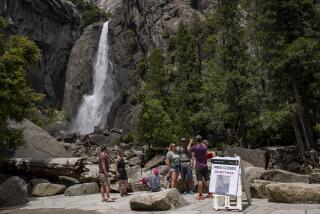Lawmaker Targets Plan for Yosemite
- Share via
SACRAMENTO — A prominent California congressman is pushing to undo key elements of the Yosemite Valley preservation plan that is meant to reduce traffic and keep campsites away from ecologically sensitive areas.
As the new chairman of the House’s national parks subcommittee, Rep. George P. Radanovich (R-Mariposa) has raised questions about what he considers too few parking spaces and campsites allowed by the Yosemite planning blueprint, which he considers biased against the needs of tourists.
“What we’re trying to do is seek a balance between environmental preservation and public use,” Radanovich said Friday. “I think they erred on the side of the environmentalists. They want to make the park so hard to get into that people just won’t come.”
But environmentalists, who fought hard to see the valley planning blueprint pushed through in the waning days of the Clinton administration, expressed fears over the direction Radanovich could steer the park restoration process, which is expected to be phased in over the next 10 to 15 years at a cost of $442 million.
Jay Watson, the Wilderness Society’s California regional director, said the reductions in campsites and parking spots--efforts meant to help nature recover from a century of trampling by mankind--represent the heart and soul of the restoration plan.
“Some of these changes would render the plan almost meaningless,” Watson said. “It is a serious challenge to the plan.”
Radanovich toured the park Thursday and Friday with the Bush administration’s new national parks director, Fran Mainella. After talks with parks officials, Radanovich said the various players agreed to go forward with noncontroversial parts of the Yosemite plan and put off the tough decisions for later.
He said no consensus was reached on two key issues--how many day parking spaces and campsites should be tucked between the valley’s sheer granite cliffs.
“Those are really the two things that we feel we need to continue working on,” Radanovich said.
Until flood waters in 1997 swept through the valley, 849 campsites were nestled in the valley, many along the banks of the Merced River. The plan proposes allowing only 500 campsites on the floor of the park, which is visited by about 4 million people each year.
Parking Feasibility Study Is Underway
Congress, however, has approved funding for a study of the feasibility of boosting the number of campsites to the historic levels desired by Radanovich. The study is to be finished by December.
Radanovich also said a decision on parking cuts will be delayed for several years while various roadway system improvements are made. The valley has about 1,600 day parking spaces, but the plan calls for a reduction to 550 in conjunction with improvements in shuttle service from remote lots outside the park.
Radanovich said he would prefer 1,200 spaces remain in the park and questions whether a robust shuttle bus system will be needed.
He said such a plan would send tourists through a virtual “Checkpoint Charlie” system. Once valley parking reached a limit, “some would be stopped and turned around,” he said. “The public is not going to tolerate a goofy system like that.”
Radanovich also vowed to use Congress’ power of the purse strings if necessary. “Having the plan is one thing,” he said. “Getting it funded by Congress is another. Those who want the plan are going to have to get money for it.”
The congressman said he is hopeful that efforts will focus on the most simple and least costly improvements. “Then, we’ll step back and see if those things solved our problems.”
Wrangling over the park’s future has dragged on for decades. But the flood waters of five years ago forced the issue.
Congress approved $178 million in emergency funds, and shortly thereafter work began in earnest on planning to carry the park into the 21st century.
After four years of planning and more than 10,000 public comments, the Yosemite Valley Plan was heralded as the solution to a century of human impact in the narrow, seven-mile valley.
It calls for the removal of several dams and bridges on the Merced River. Park offices would be shifted to adjacent towns. Meadows and woodlands sullied by development would be restored. Hiking and biking trails would be expanded. Half the park workers would be moved out of the valley.
Radanovich has long been at odds with the final version of the valley plan. After it was approved in November 2000, he called for hearings, saying the blueprint would prove too costly to taxpayers and hurt surrounding gateway communities economically linked to Yosemite.
Many business owners in those communities at Yosemite’s doorstep fear that reducing overnight accommodations inside the park and boosting bus ridership could freeze out family campers who have been their best customers over the years.
More to Read
Sign up for Essential California
The most important California stories and recommendations in your inbox every morning.
You may occasionally receive promotional content from the Los Angeles Times.










